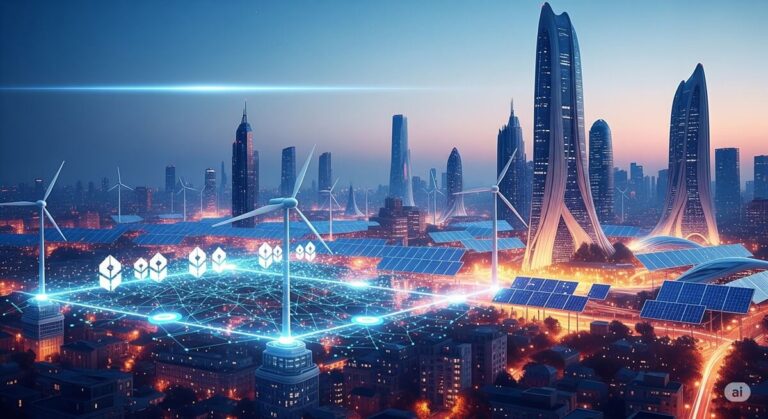The AI-Powered Green Revolution: Optimizing Energy, Waste, and Resources with Smart Tech

The global challenge of climate change and dwindling resources demands a response as intelligent as it is urgent. While renewable energy and sustainable practices have laid crucial groundwork, the true acceleration towards a greener future is now being powered by an invisible force: artificial intelligence (AI). This isn’t just about automation; it’s about transforming environmental efforts with unprecedented levels of data collection, analysis, and optimization.
Welcome to the AI-Powered Green Revolution. This article will delve into how AI in green tech is fundamentally transforming how we manage vital resources. We’ll explore how smart green solutions, fueled by the power of AI and IoT sustainability, are revolutionizing energy systems, optimizing waste management, and enabling precision in resource allocation. Get ready to discover how AI is becoming the planet’s new brain, turning raw data into tangible reductions in energy waste, more efficient resource use, and a cleaner environment.
1. The AI-Green Tech Synergy: A New Era for Sustainability
At its core, the AI-Powered Green Revolution represents a profound shift in our approach to environmental stewardship. For decades, sustainability efforts often faced limitations in processing vast, complex datasets, leading to inefficiencies and missed opportunities. AI changes this equation entirely.
- Beyond Human Capacity: AI’s remarkable ability to process colossal amounts of data, identify intricate patterns, and make predictive analyses far surpasses human capabilities. This allows for a granular understanding of environmental systems that was previously unimaginable.
- AI as an Accelerator: AI isn’t just another tool; it acts as a powerful accelerator for existing green tech innovations. By making them smarter, more efficient, and more scalable, AI empowers renewable energy systems, waste management infrastructures, and conservation efforts to operate at peak performance.
- Core Impact Areas: This transformative synergy is driving progress across critical sectors, including enhancing energy efficiency, streamlining renewable energy integration, optimizing waste management, bolstering water conservation, advancing sustainable agriculture, and building smarter, more resilient infrastructure.
2. Smart Energy: How AI is Revolutionizing Power Management
Energy is the lifeblood of modern society, and AI is injecting unparalleled intelligence into its generation, distribution, and consumption, paving the way for true AI energy management.
- Optimizing Smart Grids & Energy Distribution: AI analyzes real-time data on energy demand, supply, weather patterns, and grid conditions. This allows for dynamic routing of power, minimizing transmission losses, predicting and preventing outages, and seamlessly integrating distributed renewable sources. AI also facilitates sophisticated demand-response programs, encouraging consumers to shift energy usage to off-peak hours or when renewable generation is abundant.
- Precision Renewable Energy Forecasting & Integration: One of the biggest challenges with solar and wind power is their intermittency. AI algorithms overcome this by analyzing vast datasets, including weather patterns, historical energy output, and sensor readings, to accurately predict solar and wind generation. This reduces grid instability and optimizes the dispatch of renewable energy. AI also intelligently manages battery storage systems, ensuring energy is stored when renewables are plentiful and discharged precisely when demand peaks or renewable supply is low. For instance, Google’s DeepMind AI reduced the energy used for cooling its data centers by a remarkable 40% (resulting in 15% overall energy savings) by optimizing cooling systems. Similarly, companies like GE Renewable Energy utilize AI to fine-tune the performance of individual wind turbines.
- Building Energy Management Systems (BEMS): AI-powered BEMS, integrated with IoT sustainability sensors, continuously optimize heating, ventilation, air conditioning (HVAC), lighting, and other building systems. They respond dynamically to occupancy levels, external weather conditions, and real-time energy prices. These systems also perform predictive maintenance on equipment, preventing failures and reducing energy waste from inefficient machinery. Studies show that AI can slash building energy consumption by an impressive 10-30%.
- Industrial Energy Optimization: In manufacturing and industrial settings, AI analyzes production data to optimize machinery schedules, identify inefficiencies, and significantly reduce overall energy consumption.
3. Waste Not, Want Not: AI’s Role in Optimizing Waste & Recycling
Waste management, traditionally a labor-intensive and often inefficient process, is being fundamentally transformed by waste management AI, leading to more circular economies.
- Automated Waste Sorting & Recycling: AI-powered robots equipped with advanced computer vision technology can rapidly and accurately identify and sort different types of waste materials—plastics, paper, metals, and more. This dramatically improves recycling rates, enhances the purity of sorted materials, and reduces human exposure to hazardous waste. Companies like AMP Robotics are at the forefront of deploying these AI-driven systems.
- Predictive Waste Generation & Optimized Collection: AI algorithms analyze historical waste data, population density trends, and even public event schedules to accurately forecast waste generation patterns. This intelligence allows for the optimization of waste collection routes for trucks, leading to significant reductions in fuel consumption, emissions, and operational costs for municipalities. Furthermore, smart bins equipped with sensors alert collection services only when they are full, preventing unnecessary trips.
- Waste-to-Energy Optimization: AI can fine-tune the combustion processes within waste-to-energy plants to maximize energy output while simultaneously minimizing harmful emissions, creating a more efficient and cleaner conversion.
4. Precision & Preservation: AI in Broader Resource Optimization
Beyond energy and waste, AI is bringing unprecedented precision to the management of our most vital natural resources, driving true resource optimization.
- Precision Agriculture: AI analyzes vast amounts of data from drones, ground sensors, and satellites to provide hyper-localized insights. This enables farmers to:
- Optimize irrigation, leading to significant water conservation.
- Apply fertilizers with pinpoint accuracy, reducing runoff and chemical use.
- Detect crop diseases and pests early, allowing for targeted interventions and minimizing pesticide application.
- Optimize planting and harvesting times for maximum yield and resource efficiency.
- Smart Water Management: AI algorithms are instrumental in detecting leaks in vast water distribution networks, minimizing critical water loss. They also predict water demand based on weather patterns and consumption trends, optimizing reservoir management and treatment plant operations. Real-time water quality monitoring helps swiftly identify potential pollution sources.
- Sustainable Supply Chain & Logistics: In complex global supply chains, AI optimizes transportation routes to minimize fuel consumption and associated emissions. Predictive analytics help reduce waste from overstocking or spoilage. AI also enhances traceability, promoting ethical sourcing and reducing the environmental impact throughout the entire supply chain.
- Materials Science & Product Design: AI is accelerating the discovery and design of novel sustainable materials, such as more efficient batteries, biodegradable plastics, or low-carbon concrete. It also optimizes product design for reduced material use, extended lifespans, and improved recyclability.
5. The IoT Backbone: Fueling AI’s Green Insights
The intelligence of AI in the green revolution relies fundamentally on a vast network of interconnected devices: the Internet of Things (IoT).
- Data Collection Engine: IoT sensors, embedded everywhere from wind turbines and solar panels to smart meters, waste bins, farm equipment, and water pipes, act as the “eyes and ears” of the AI-Powered Green Revolution. They constantly collect the colossal datasets that AI needs to learn from, analyze, and make informed decisions.
- Real-time Responsiveness: IoT provides the immediate, real-time data streams that allow AI to react instantly to changing conditions. This could mean adjusting energy distribution in response to a sudden weather shift affecting renewable output or dispatching a crew to address a pipe burst.
- Actionable Feedback Loops: Crucially, IoT facilitates the implementation of AI’s recommendations. AI analyzes data and sends commands back to IoT-enabled devices, closing the loop between analysis and real-world action—for instance, an AI system instructing smart thermostats to adjust temperature or optimizing irrigation systems. IoT transforms AI’s insights into tangible, automated changes.
6. The Tangible Benefits: Why AI is Indispensable for Green Goals
The integration of AI and green tech offers a compelling array of benefits that are critical for achieving global sustainability goals:
- Enhanced Efficiency & Cost Savings: AI drives significant reductions in energy, water, and material consumption, translating directly into lower operational costs and optimized resource utilization across industries.
- Substantial Emissions Reduction: By optimizing energy use, improving renewable integration, and streamlining industrial processes, AI directly contributes to a significant cut in greenhouse gas emissions.
- Improved Resource Allocation: AI enables a smarter, data-driven approach to using finite natural resources, minimizing waste and maximizing utility.
- Predictive & Proactive Management: Moving beyond reactive problem-solving, AI allows for the anticipation and prevention of issues, from equipment failures (predictive maintenance) to energy demand spikes.
- Scalability & Complexity Management: AI solutions can effectively manage and optimize vast, complex systems—whether it’s an entire city’s grid or a global supply chain—with a level of precision and speed previously unattainable.
- Innovation Acceleration: AI significantly speeds up the discovery, design, and deployment of new green technologies and solutions, from novel materials to more efficient system designs.
7. Navigating the Future: Challenges & Ethical Considerations in AI for Sustainability
While the promise of the AI-Powered Green Revolution is immense, it’s crucial to acknowledge and address the challenges that come with this powerful technology.
- Data Privacy & Security: The reliance on vast amounts of operational and potentially sensitive data necessitates robust cybersecurity measures and clear ethical frameworks to protect privacy and prevent misuse.
- AI’s Own Energy Consumption: Training and operating large, complex AI models can be energy-intensive. It’s vital to develop more energy-efficient AI algorithms and to power the data centers running AI with renewable energy sources to avoid negating environmental gains.
- Initial Investment & Integration Costs: Implementing sophisticated smart green solutions often requires significant upfront capital and complex integration efforts with existing infrastructure.
- Data Quality & Bias: The effectiveness of AI is highly dependent on the quality and unbiased nature of the data it’s fed. Poor or biased data can lead to suboptimal or even detrimental environmental and operational outcomes.
- Ethical AI Development: Ensuring AI systems are developed and deployed responsibly is paramount, considering potential unintended consequences such as job displacement in traditional industries or monopolization of resources.
- Regulatory Frameworks: Governments and international bodies need to develop agile and forward-thinking regulations that can keep pace with the rapid advancements in AI and green tech to ensure responsible deployment.
Conclusion: The Intelligent Path to a Sustainable Planet
The AI-powered Green Revolution is not just a technological advancement; it’s a fundamental shift in how humanity can tackle its most pressing environmental challenges. By leveraging the immense power of AI in green tech and the pervasive connectivity of IoT sustainability, we are moving toward unprecedented efficiencies in energy management, waste reduction, and resource optimization.
The true genius of AI in this context lies in its ability to convert raw, disparate data into actionable intelligence. It enables us to transition from reactive environmental efforts to proactive, intelligent, and scalable solutions that were once confined to the realm of science fiction. The journey ahead demands continued innovation, careful ethical consideration, and strategic investment. Yet, the path is clear: AI is poised to accelerate our transition to a smarter, more resilient, and genuinely green planet.
Are you ready to embrace the intelligence that can save our planet? Explore how AI and smart tech can transform your business or lifestyle today, and become a part of the AI-Powered Green Revolution.
Frequently Asked Questions (FAQs) About AI in Green Tech
Q1: How does AI help manage energy more efficiently?
A: AI optimizes smart grids, predicts renewable energy output, manages building energy systems based on real-time data, and streamlines industrial energy consumption, leading to significant efficiency gains and cost savings.
Q2: Can AI really improve recycling and waste management?
A: Yes, AI-powered robots enhance waste sorting accuracy and speed, while AI algorithms optimize waste collection routes and predict generation patterns, reducing fuel consumption and improving recycling rates.
Q3: What role does IoT play in AI-driven sustainability solutions?
A: IoT sensors collect the vast amounts of real-time data (from devices like smart meters, turbines, and bins) that AI needs to analyze and generate actionable insights. IoT also enables AI’s recommendations to be implemented automatically, closing the loop.
Q4: What are some real-world examples of AI being used for environmental benefit?
A: Examples include Google’s DeepMind AI optimizing data center cooling, AMP Robotics using AI for waste sorting, AI-driven precision agriculture for optimized water and fertilizer use, and AI algorithms detecting leaks in water networks.
Q5: Are there any downsides or challenges to using AI for green initiatives?
A: Yes, challenges include managing data privacy and security, addressing the energy consumption of AI itself, high initial investment costs for implementation, ensuring data quality and avoiding bias, and navigating the ethical implications of AI deployment.



